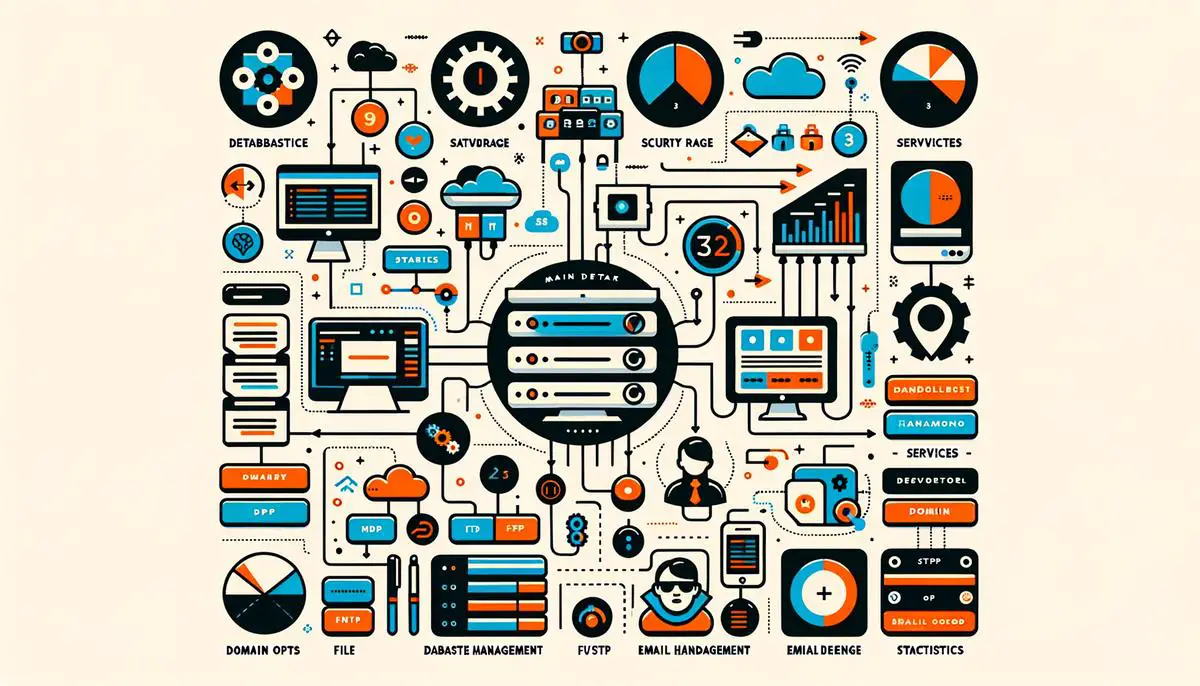Web hosting control panels are the unsung heroes behind the scenes of every successful website. They provide a crucial bridge between complex server management tasks and the user, simplifying what would otherwise be an overwhelming process. This article aims to shed light on these essential tools, exploring their features, benefits, and the future trends that will shape their evolution. By understanding web hosting control panels better, users can make more informed decisions about managing their online presence effectively.
Overview of Web Hosting Control Panels
Web hosting control panels are essentially the dashboards that people use when they’ve got websites to run and servers to manage. Think of them like the command center for everything that makes a website work behind the scenes. These panels allow users – whether they’re seasoned tech experts or total novices getting their feet wet in the digital world – to handle a whole bunch of necessary tasks without having to understand complicated coding languages or navigate complex server protocols.
At their core, these control panels make the process of managing a website a lot more straightforward. They offer a graphical interface – kind of like how a smartphone gives you icons to tap rather than making you type commands – that lets you do a variety of important stuff. For example, if you’re setting up a new website, you can use a control panel to register and manage your domain names. That’s like saying to the internet, “Hey, over here, this is my spot.”
Then there’s the whole business of setting up email accounts. If you’ve got a website, chances are you’re going to want an email that matches your domain for a more professional look. Web hosting control panels let you create and manage these email accounts easily. So instead of juggling different platforms or steep learning curves, it’s all there in one place.
Another big feature is file management. This includes uploading your website’s content, keeping it organized, and making updates when needed. Again, the goal here is simplicity and efficiency – ensuring that anyone, regardless of their technical know-how, can keep their website’s content fresh and engaging without too much hassle.
In essence, web hosting control panels demystify a lot of the back-end work that goes into running a successful website. They serve as the vital link between the website owner and the nitty-gritty of server management. Without these panels, you’d be looking at a much steeper learning curve and possibly having to hire professionals for tasks you can now do yourself with a few clicks.
Why are they crucial? Well, imagine trying to manage a bustling restaurant kitchen without ever being able to step into the kitchen itself. Web hosting control panels give you access to all the tools and data you need to keep your ‘digital kitchen’ running smoothly, offering both visibility and control over your online presence. This not only streamlines the process but also saves valuable time and resources – letting website owners focus more on content and less on the complexities of web hosting.

Comparative Analysis of Popular Web Hosting Control Panels
When it comes to diving into the specifics of cPanel, Plesk, and DirectAdmin, it’s clear that each of these web hosting control panels brings its own set of cards to the table. Let’s tease apart how they tackle user interface, operating system compatibility, ease of use, and unique features one by one.
Starting with the user interface (UI), cPanel sports a pretty straightforward and intuitive design. It’s like walking into a well-organized room where everything has its place. This makes finding and using features relatively easy, even for folks not too tech-savvy. On the other hand, Plesk offers a sleeker, more modern look that might appeal to the aesthetics-driven user. Its layout is clean, making it easy on the eyes and fairly simple to navigate. DirectAdmin, while fully functional, tends to lag a bit behind in the UI beauty contest. It’s like the older, less flashy car that gets you where you need to go, but without the bells and whistles.
On the topic of compatibility with operating systems, Plesk takes the cake for flexibility. It’s like the friend who gets along with everyone at the party, playing nice with both Windows and Linux platforms. cPanel, in contrast, sticks primarily to Linux, showing a bit of preference there. For those in the Windows camp, this could be a bit of a bummer. Similarly, DirectAdmin favors Linux, which isn’t a big deal unless you’re married to the idea of hosting on a Windows server.
When we talk about ease of use, it’s a bit of a toss-up depending on your background. Beginners might lean towards cPanel or Plesk because of their user-friendly interfaces and wide range of documentation available online. It’s like having a guidebook while traveling in a foreign country. DirectAdmin, because of its less intuitive design, might require a steeper learning curve, almost like learning to ride a bike for the first time again.
Now, let’s shine a light on
- unique features
Each of these control panels has its perks and quirks, making the choice highly personal and dependent on specific needs and preferences. Whether it’s the familiar convenience of cPanel, the sleek versatility of Plesk, or the straightforward simplicity of DirectAdmin, understanding their character can help demystify which would serve as the best co-pilot in your web hosting journey.

Security Features in Web Hosting Control Panels
Moving onto the facet of security within the realm of web hosting control panels, it behooves website operators to stay informed about the protective measures these essential tools offer. Integral to safeguarding a website’s infrastructure, the security features embedded in web hosting control panels can often be the difference between smooth sailing and unforeseen downtime due to security breaches.
One cannot overstate the importance of SSL/TLS management, a core feature of control panels that commands attention. SSL (Secure Sockets Layer) and TLS (Transport Layer Security) management tools enable website owners to encrypt the data exchanged between a server and its visitors, thereby ensuring the confidentiality and integrity of the information. Through a control panel, installing and renewing SSL certificates becomes a task of lesser complexity, demystifying what can otherwise be a daunting endeavor for the uninitiated.
Equally critical is the ability of these panels to configure firewalls. A robust firewall serves as a website’s first line of defense against unwanted intrusions, distinguishing between safe and potentially harmful traffic. Control panels typically simplify the process of setting up rule-based firewalls, which can be tailored to meet the unique security needs of each website. By filtering out questionable traffic before it reaches the server, control panels play a pivotal role in preempting potential security incidents.
Malware scanning is another vital functionality found in web hosting control panels. With cyber threats continually evolving in sophistication, the provision for regular scanning of a website for malware is not just reassuring; it’s essential. Control panels usually incorporate tools that automate the detection and, in many cases, the removal of malware. This safeguard helps in identifying threats at an early stage, significantly mitigating the risk of serious compromises to a website’s security.
Beyond these specific features, the overarching theme in web hosting control panel security is the importance of regular updates and patches. Cybersecurity is an arms race, with both threat actors and defenders constantly evolving their tactics. As such, control panels are frequently updated to address newfound vulnerabilities and bolster their defense mechanisms. For website owners, ensuring their control panel is upto-date is a simple yet effective step towards fortifying their site against the ever-present cloud of cyber threats.
In wrapping up this section on the security measures of web hosting control panels, it becomes clear that while these platforms serve a multiplicity of functions aimed at easing website management, their role in maintaining a site’s security posture cannot be understated. From managing SSL/TLS certifications to configuring firewalls and scanning for malware, these tools offer a comprehensive suite of features designed to protect websites from a wide array of security threats.

Customization and Extensibility
Now, when we dive into the world of web hosting control panels, one aspect that really stands out is customization. For many users, having the ability to tweak their hosting environments is less about luxury and more about necessity. Let’s break down what this actually involves, starting with themes, plugins, and modules.
Starting with themes, it’s interesting to note how they can dramatically change the look and feel of a control panel. For folks who spend a good chunk of their day managing websites, this isn’t just about aesthetics. A visually appealing interface can make the task at hand less tedious and more enjoyable. Some control panels come with a selection of themes, while others allow users to create or install custom ones. This means if someone finds the default theme too bland or overly complicated, they have options to change it.
Plugins extend the functionality of control panels in significant ways. Maybe you need a better way to analyze your site’s traffic, or perhaps you’re looking for more robust backup options. There’s likely a plugin out there for that. And if there isn’t, the community around major hosting control panels might offer support in developing one. It’s like having a Swiss Army knife; you can add or remove tools based on what the job requires.
Modules play a similar, albeit slightly more technical role. They can add new features or enhance existing ones within the control panel. Need more advanced database management tools? There’s a module for that. Looking for deeper integration with cloud services? Again, modules can come to the rescue. What’s fascinating here is how you can effectively build a control panel that mirrors the specific needs and goals of your website or online platform.
It’s not just about adding things, either. Customization also means being able to strip away features you don’t use, which can streamline your workspace and reduce clutter. This level of tailoring helps ensure that users can focus on tasks that matter most, potentially leading to better productivity and less frustration.
In reality, while not everyone dives into the nitty-gritty of customization, the fact that these options exist makes web hosting control panels incredibly flexible tools. Whether you’re running a small blog or managing several large e-commerce sites, the ability to customize your control panel can significantly enhance both functionality and user experience.
Think of it as setting up your ideal workspace. Everyone has their own preference for how things should look and what tools should be within arm’s reach. Web hosting control panels acknowledge this diversity by offering a sandbox where each user can create their perfect environment. This not only demystifies much of the web management process but makes it more accessible to users with varying levels of technical expertise.
To sum up, the customization options found within web hosting control panels serve a critical role in helping users align the tool with their specific needs. Through themes, plugins, and modules, these platforms offer a degree of flexibility and personalization that can significantly impact the efficacy and satisfaction in web management activities.

The Future of Web Hosting Control Panels
Shifting our gaze to the horizon of web hosting control panels, it becomes clear that evolution is not just impending; it is already underway. The wheels of progress turn swiftly, spurred by rapid technological advancements. Here, we delve into the future-shaping trends and innovations seamlessly integrating with web hosting control panels. Notably, these developments are poised to revolutionize website and server management in the years to come.
One significant stride forward is the integration of Artificial Intelligence (AI) and machine learning technologies. You might be wondering, how does this actually look in the day-to-day? Imagine a control panel that not only responds to your commands but also predicts your next move, offering suggestions to optimize your website’s performance based on real-time data analysis. This isn’t science fiction. An AI-infused control panel could automate routine tasks, flag potential issues before they become problematic, and offer insights for data-driven decisions.
Cloud compatibility represents another frontier. Control panels are stretching beyond the confines of traditional hosting environments to embrace the cloud. This means users can manage not only their web content but also their cloud resources from a single, unified dashboard. The advantages? Streamlined operations and the convenience of managing virtual servers and cloud instances without switching platforms or learning new tools.
Mobile accessibility cannot be overlooked. In an age where smartphones are omnipresent, the demand for mobile-friendly web hosting control panels is escalating. Providers are responding by developing responsive designs and dedicated apps that enable website administrators to manage their online presence anytime, anywhere. This shift toward mobile accessibility ensures that website upkeep and server management are no longer tethered to desktop environments, offering unparalleled flexibility to webmasters on the go.
As we survey these developments, it’s apparent that web hosting control panels are not just adapting; they are leading the charge towards a more integrated, intelligent, and accessible future. These advancements spotlight an ecosystem in transition—an ecosystem that is increasingly responsive to the needs and demands of its users. The future of web hosting control panels will likely continue to unfold in this dynamic sphere, where technology’s cutting edge meets the practical needs of website and server management.

Photo by bash__profile on Unsplash
The landscape of web hosting control panels is ever-evolving, driven by technological advancements and changing user needs. As we look towards the future, it’s clear that these tools will continue to become more intelligent, flexible, and accessible. This evolution promises to make website and server management even more efficient and user-friendly than it is today. By staying informed about these changes and embracing new features as they come, users can ensure that they are always at the forefront of digital management practices. Ultimately, web hosting control panels are set to play an even bigger role in empowering individuals to take full control of their digital spaces with confidence.
